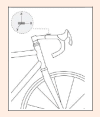The effects of surface-induced loads on forearm muscle activity during steering a bicycle
- PMID: 24149159
- PMCID: PMC3772596
The effects of surface-induced loads on forearm muscle activity during steering a bicycle
Abstract
On the bicycle, the human upper extremity has two essential functions in steering the bicycle and in supporting the body. Through the handlebar, surface- induced loads are transmitted to the hand and arm of the bicycle rider under vibration exposure conditions. Thus, the purpose of the study was to investigate the effect of vibration exposure on forearm muscle activity for different road surfaces (i.e. smooth road, concrete stone pavement, rough road) and for different bicycles. Ten subjects participated in experiments and two types of bicycles, i.e. Road Bike (RB) and Mountain Bike (MTB) are compared. The acceleration magnitudes were dominant along x and z-axes. The r.m.s acceleration values in the z direction at the stem of MTB were at most 2.56, 7.04 and 10.76 m·s(-2) when pedaling respectively on asphalt road, concrete pavement and rough road. In the case of RB the corresponding values were respectively 4.43, 11.75 and 27.31 m·s(-2). The cumulative normalized muscular activity levels during MTB trials on different surfaces had the same tendency as with acceleration amplitudes and have ranked in the same order from lowest to highest value. Although road bike measurements have resulted in a similar trend of increment, the values computed for rough road trials were higher than those in MTB trials. During rough road measurements on MTB, rmsEMG of extensor muscles reached a value corresponding to approximately 50% of MVC (Maximum Voluntary Contraction). During RB trials performed on rough road conditions, rmsEMG (%MVC) values for the forearm flexor muscles reached 45.8% of their maximal. The level of muscular activity of forearm muscles in controlling handlebar movements has been observed to be enhanced by the increase in the level of vibration exposed on the bicycle. Since repeated forceful gripping and pushing forces to a handle of a vibratory tool can create a risk of developing circulatory, neurological, or musculoskeletal disorder, a bicycle rider can be considered vulnerable to developing vibration related overuse injuries and/or performance diminishing consequences. Key PointsThe muscular activity level in the forearms increases in response to random vibration transmitted to the bicycle to control handlebar movements.The level of vibration transmission depends on irregularities on road surface and bicycle type.A bicycle rider can be considered vulnerable to developing vibration related overuse injuries and/or performance diminishing consequences.
Keywords: Vibration transmission; cycling; electromyography; mountain bike; road bike.
Figures




Similar articles
-
Evaluation of human exposure to vibration in the hand-arm system during motorcycle riding activities.Work. 2023;75(4):1319-1330. doi: 10.3233/WOR-220269. Work. 2023. PMID: 36744356
-
The effect of road-bike damping on neuromuscular short-term performance.Sports Biomech. 2020 Dec;19(6):723-737. doi: 10.1080/14763141.2020.1797153. Epub 2020 Sep 18. Sports Biomech. 2020. PMID: 32942954
-
Effects of vibratory massage therapy on grip strength, endurance time and forearm muscle performance.Work. 2021;68(3):619-632. doi: 10.3233/WOR-203397. Work. 2021. PMID: 33612507
-
The effect of mountain bike suspensions on vibrations and off-road uphill performance.J Sports Med Phys Fitness. 2007 Jun;47(2):151-8. J Sports Med Phys Fitness. 2007. PMID: 17557052
-
Mountain Biking Injuries.Curr Sports Med Rep. 2017 Nov/Dec;16(6):404-412. doi: 10.1249/JSR.0000000000000429. Curr Sports Med Rep. 2017. PMID: 29135638 Review.
Cited by
-
The Effect of Handlebar Height and Bicycle Frame Length on Muscular Activity during Cycling: A Pilot Study.Int J Environ Res Public Health. 2022 May 28;19(11):6590. doi: 10.3390/ijerph19116590. Int J Environ Res Public Health. 2022. PMID: 35682173 Free PMC article.
-
Analysis of the Effect of Training Driving on Electromyographic Parameters in Trained Karting Drivers: A Study of Fatigue and Its Relationship with Training Practice.J Funct Morphol Kinesiol. 2025 May 26;10(2):190. doi: 10.3390/jfmk10020190. J Funct Morphol Kinesiol. 2025. PMID: 40566440 Free PMC article.
-
Low Back Pain in Cycling. Are There Differences between Road and Mountain Biking?Int J Environ Res Public Health. 2023 Feb 21;20(5):3791. doi: 10.3390/ijerph20053791. Int J Environ Res Public Health. 2023. PMID: 36900802 Free PMC article. Clinical Trial.
References
-
- Åström C., Lindkvist M., Burström L., Sundelin G., Karlsson J. (2009) Changes in EMG activity in the upper Trapezius muscle due to local vibration exposure. Journal of Electromyography and Kinesiology 19, 407-415 - PubMed
-
- Berry M.J., Koves T.R., Benedetto J.J. (2000) The influence of speed, grade and mass during simulated off-road bicycling. Applied Ergonomics 31, 531-536 - PubMed
-
- Bosco C., Cardinale M., Tsarpela O. (1999) Influence of vibration on mechanical power and electromyogram activity in human arm flexor muscles. European Journal of Applied Physiology 79, 306-311 - PubMed
-
- Bovenzi M. (2006) Health risks from occupational exposures to mechanical vibrattion. La Medicina del lavoro 97(3), 535-541 - PubMed
LinkOut - more resources
Full Text Sources
